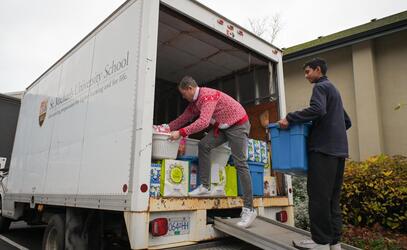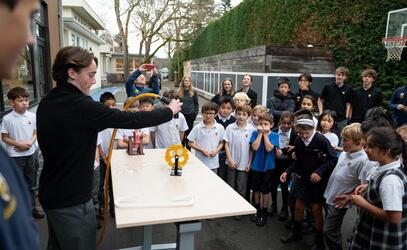Imagine going through your 12-year-old’s report card and all they care about is one letter. “Am I an ‘A’ student or a ‘B’ student?” Now imagine instead that they focus on how well they perform, where they excel and where they can improve.
This year, like our Junior School students, Middle School students will see no letter grades on their report cards. They haven’t seen percentages on tests or assignments for years now and only sometimes letter grades. We have removed the grade to focus on more effective ways of assessing and communicating student learning that focuses on growth. (Kindergarten to Grade 3 students have never had letter grades, and we removed them in Grades 4 and 5 last year. The change this year is for Grades 6-8.)
Removing letter grades is not a shift towards a feel-good, kumbaya education where academics don’t matter. It’s the exact opposite, in fact. This is academic rigour.
When a student receives a B in Humanities 7, for example, there’s a lot of information missing. What are their strengths and where are they struggling in Humanities? Did they do really well in a specific area? Do they need to focus on an area of improvement? A letter grade doesn’t offer that clear picture. It's just an average of how well they did in a variety of areas over several months.
Parents and students will continue to receive an in-depth evaluation of their performance in each subject. The feedback highlights what the student knows and is able to do in each course.
Research shows that a grading a culture limits a student’s potential. Students fixate on letter grades, which boxes them into a mindset of "this is what I am." We want report cards to help them get into a mindset of "this is what I can do to improve." Students need to know exactly where they are, where they need to go and how to get there.
Academic rigour without letter grades
When a student receives a score or letter grade they almost always take that number or letter and compare it with their peers. An averaged ranking lumps all students into the same category. It doesn't acknowledge that each student has strengths and areas to work on and it doesn’t recognize that students learn at different paces.
At the start of the term or unit of study, teachers still outline learning outcomes: what all students need to know, understand and do each term. These outcomes are directed by the curriculum and are a blend of content (like numeracy and literacy) and skills (like problem-solving or communication).
The report card you’ll get will look nearly identical to what you’re used to seeing. Each subject is listed and each subject is still broken down into learning outcomes. Students will know how well they're doing related to each outcome and will have feedback from teachers specific to their growth.
Student-Teacher-Parent Conferences
In addition to the report card changes, this year we’ve introduced Student-Teacher-Parent Conferences (STeP). Twice this year, students, parents and TAG teachers will get together to discuss the student as a learner.
The focus of these meetings is on how students are developing life skills, like resiliency and curiosity, that will help them be successful in school and beyond. (We’re also still hosting two Parent-Teacher Conferences for parents to meet with teachers to discuss the child’s performance in each subject.)
Involving the student in this process gives them ownership of their learning. It allows them to better set goals, with the support of their teacher and parents, to help them grow.
Students are the ones who decide if they’re going to make changes so they need to be involved in these discussions.
This increase in face-to-face contact will give parents and students more information and a more accurate picture.
Why the change?
Two years ago we made it a priority to look deeper at this topic. We revisited how we communicate student learning and what information we share with parents. We looked at all the ways we share this information – from report cards and student portfolios to Parent-Teacher Interviews.
At the same time, the B.C. Ministry of Education made changes to the curriculum. One of the recent changes was schools were given permission to design their own reporting systems. Our Middle School teachers unanimously supported getting rid of letter grades.
Students have been assessed based on learning outcomes at SMUS since 2011. In the six years since that change, the B.C. Ministry of Education still required letter grades. Now that this requirement is gone, students can focus on the depth of their learning and where they can improve without the negative effects of grades.
What we’re doing isn’t unique to SMUS. We’ve done a lot of homework around this topic before making these changes. Middle School teacher Ms. Tanya Lee wrote about the downside of letter grades in February 2016 after visiting a school in New Hampshire that doesn’t have report cards.
As The Globe & Mail wrote earlier this year, B.C. is leading the way in Canada with experimenting with grades-free report cards.
“Canada is late to the game in reforming the traditional grades-focused approach to evaluation. … U.S. college admissions, for instance, involve far more than looking at just grades or college admissions scores," said Sandra Matheson, executive director of British Columbia's Institute for Public Education, in The Globe & Mail piece.
Moving away from grades isn’t a fad in education. It’s a movement based on decades of research.
Studies have found that grades hinder development. Grades diminish student interest, they encourage students to do the least amount of work to get the best possible grade, and grades tend to reduce the quality of students’ thinking.
https://www.youtube.com/watch?v=lfRALeA3mdU
We also know that teacher feedback is one of the most powerful tools in encouraging growth. Studies show that when feedback is accompanied by a letter grade or a mark, students ignore the feedback altogether; the first thing they’ll look at is their grade, the second thing they look at is someone else’s grade. (Download University of London professor Dylan Wiliam's article to read more.)
Students at the Senior School will still have letter grades and percentages. Most universities and colleges still look at percentages and letter grades. What introducing letter grades in Grade 9 does (as opposed to Grade 4 or Grade 6) is it gives students a lot more time in younger years to know who they are as learners. They will come into the Senior School better equipped to learn and better equipped to set goals to improve their learning.
It's important for us to see our students grow as learners. It’s important for us that our students graduate knowing what they need to know and having the skills they need to succeed in life after high school. Letter grades do not help us meet these goals.
The changes we’ve made around communicating student learning – no letter grades, STeP conferences and more in-depth feedback – are what’s best for students. Imagine now the conversations you will have this year with your child when they bring home their report card and what matters to them is their learning.
On Monday (Oct. 2) we’re hosting a coffee talk for Middle School parents in our Chapel from 8-9 a.m. on this very subject. We hope to answer the pressing questions you have about our decision to remove letter grades at the Middle School. Parents of Junior and Senior School students are also welcome to attend.



